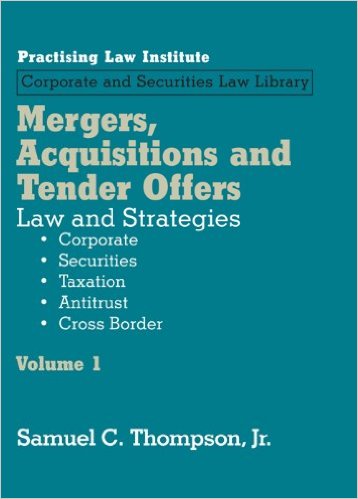Reunification
For up-to-date information regarding the reunification of Penn State's two law schools, please click here.
For up-to-date information regarding the reunification of Penn State's two law schools, please click here.
UNIVERSITY PARK, Pa. — The recently published fourth edition of a casebook on mergers and acquisitions by Penn State Law professor Samuel C. Thompson Jr. provides a transactional approach to M&A issues and includes new and current materials reflecting developments in the law since the third edition was released in 2008. The fourth edition of Business Planning for Mergers and Acquisitions was published by Carolina Academic Press.
Divided into four parts and 28 chapters, the book covers corporate, securities, antitrust, federal income taxation, accounting, and valuation issues that often arise during mergers and acquisitions. Written to help train law students in the art of completing successful M&A deals, the book begins by looking at issues that are likely to be faced in both consensual and hostile transactions. Part I covers shareholder voting and dissenting rules, directors’ fiduciary duties, basic securities considerations, tax aspects, accounting treatment, valuation, antitrust, pre-merger notification, due diligence, and preliminary deal documents.
Part II dives deep into consensual transactions, exploring several types of M&A deals, ranging from various acquisitions of closely and publicly held corporations to leveraged buyouts and going private. It also covers the drafting of agreements for these various types of acquisitions.
Part III is devoted to hostile transactions and the state and federal laws that govern these types of deals. It covers proxy contests, the Williams Act, tender offers, and the regulatory schemes surrounding defensive tactics employed by targets.
The final section of the book provides an introduction to special M&A topics including spin-offs, international acquisitions, joint ventures, ethics, and transactions in highly regulated industries like banking, telecommunications, and health care.
Reflecting the growing importance of shareholder activism, the fourth edition of Business Planning for Mergers and Acquisitions includes a new chapter dedicated to the topic. The fourth edition also organizes all of the cases dealing with fiduciary duties into one chapter.
Thompson serves as the Arthur Weiss Distinguished Faculty Scholar at Penn State Law and directs the law school’s Center for the Study of Mergers and Acquisitions, which conducts research and hosts continuing legal education programs on legal and economic issues that arise in mergers and acquisitions. In addition to M&A issues, Thompson teaches Basic Federal Income Tax, Corporate Tax, International Tax, and Contracts.

He has consulted on M&A issues for the Federal Trade Commission and testified before Congress on tax policy. He previously served as a professor in residence at the European Commission’s Antitrust Merger Taskforce in Brussels and as the Jacquin D. Bierman Visiting Professor of Taxation at Yale Law School.
Thompson is also the author of Mergers, Acquisitions & Tender Offers, published by the Practising Law Institute. This five-volume treatise includes best practices, planning tips, checklists, and sample documents for the entire M&A process. It focuses on both private and public acquisitions and covers both negotiated and hostile transactions. The book takes a practical approach and contains deal documents illustrating the practical application of each topic.
Originally published in 2010, half of the chapters are updated in January and half in June; the fifth volume was added in February 2015.